We’ve all been there – reaching for natural remedies when our throats feel scratchy or our chests feel tight. Mullein tea stands out as one of nature’s most trusted respiratory allies, offering gentle relief that’s been cherished for centuries. This fuzzy-leafed plant transforms into a soothing golden brew that’s surprisingly easy to make at home.
What makes mullein tea so special? Its naturally mild flavor and impressive respiratory benefits make it perfect for anyone seeking a caffeine-free herbal remedy. We love how this humble wildflower creates such a comforting cup of wellness with just a few simple steps.
Whether you’re dealing with seasonal discomfort or simply want to add a nourishing herbal tea to your routine, we’ll show you exactly how to brew the perfect cup. The process is wonderfully straightforward, and the results speak for themselves – a warm, healing drink that’s been trusted by herbalists and home remedies enthusiasts alike.
What You’ll Need
Making mullein tea requires minimal equipment and just a few simple ingredients. We’ll walk you through everything needed to brew this soothing herbal remedy at home.
Equipment
We recommend gathering these basic tools before starting your mullein tea preparation:
- Tea strainer or fine mesh sieve – Essential for filtering out plant material
- Medium saucepan – For heating water and steeping the herbs
- Measuring cups – To ensure proper water ratios
- Teacup or mug – For serving your finished tea
- Cheesecloth or coffee filter – Optional extra filtration for smoother tea
- Wooden spoon – For gentle stirring during the steeping process
Ingredients
Our mullein tea recipe calls for these simple ingredients:
- 2 tablespoons dried mullein leaves – The star ingredient providing respiratory benefits
- 2 cups filtered water – Pure water enhances the tea’s natural flavor
- 1 teaspoon honey – Optional natural sweetener that complements mullein’s mild taste
- 1 slice fresh lemon – Optional addition for extra vitamin C and citrus notes
- 1 teaspoon dried chamomile – Optional blend companion for added relaxation benefits
Fresh mullein leaves work wonderfully if you have access to them. Use 3 tablespoons of fresh leaves instead of 2 tablespoons dried for the same potency. Quality matters when selecting your mullein so choose organic sources when possible for the purest therapeutic benefits.
How to Prepare Mullein Leaves
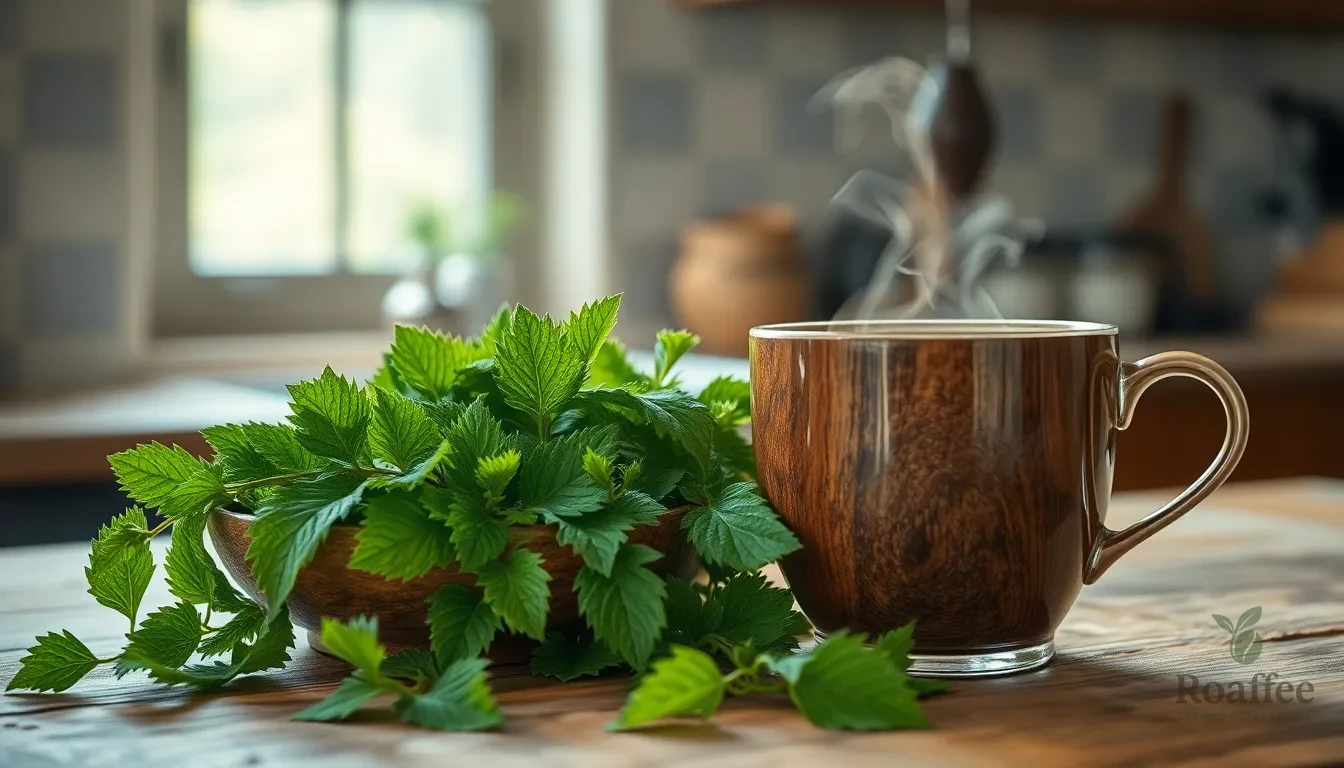
Now that we have our ingredients and equipment ready, let’s explore the proper preparation methods for mullein leaves. Both fresh and dried mullein leaves create effective tea, though each requires exact techniques for optimal results.
Fresh Mullein Preparation
Fresh mullein leaves offer a more potent flavor profile but require careful handling due to their natural irritants. We recommend using a precise ratio of 2 parts fresh mullein leaves to 32 parts water by weight for the best extraction.
Begin by measuring your fresh mullein leaves and placing them in your teacup or brewing vessel. Pour boiling water directly over the leaves, ensuring complete coverage. Allow the mixture to steep for exactly 10 minutes to extract the beneficial compounds without over-intensifying the natural bitterness.
Strain the tea thoroughly using a fine mesh strainer or cheesecloth before drinking. This step proves crucial since fresh mullein leaves contain fine hairs that can irritate the throat if consumed. The resulting tea delivers a stronger, more robust flavor compared to its dried counterpart.
Dried Mullein Preparation
Dried mullein leaves provide a gentler approach to tea preparation and remain the preferred choice for regular consumption. We suggest using 1 to 2 teaspoons of dried, crumbled mullein leaves per cup of water, adjusting the amount based on your taste preferences.
Place the dried leaves in a clean jug or jar, then add just-boiled water to cover the leaves completely. Cover the container and steep for approximately 10 minutes for a standard strength tea. For those preferring a milder flavor, we recommend cold steeping the leaves in refrigerated water for 8 to 12 hours.
| Preparation Method | Steeping Time | Water Temperature | Leaf Ratio |
|---|---|---|---|
| Hot Steep | 10 minutes | Just-boiled | 1-2 tsp per cup |
| Cold Steep | 8-12 hours | Cold/refrigerated | 1-2 tsp per cup |
Strain the infusion through a fine mesh or cheesecloth before drinking to remove any remaining plant material. The finished tea presents a mild earthy flavor with slight bitter notes. We recommend consuming up to 3 cups per day to support respiratory health effectively.
Instructions for Making Mullein Tea
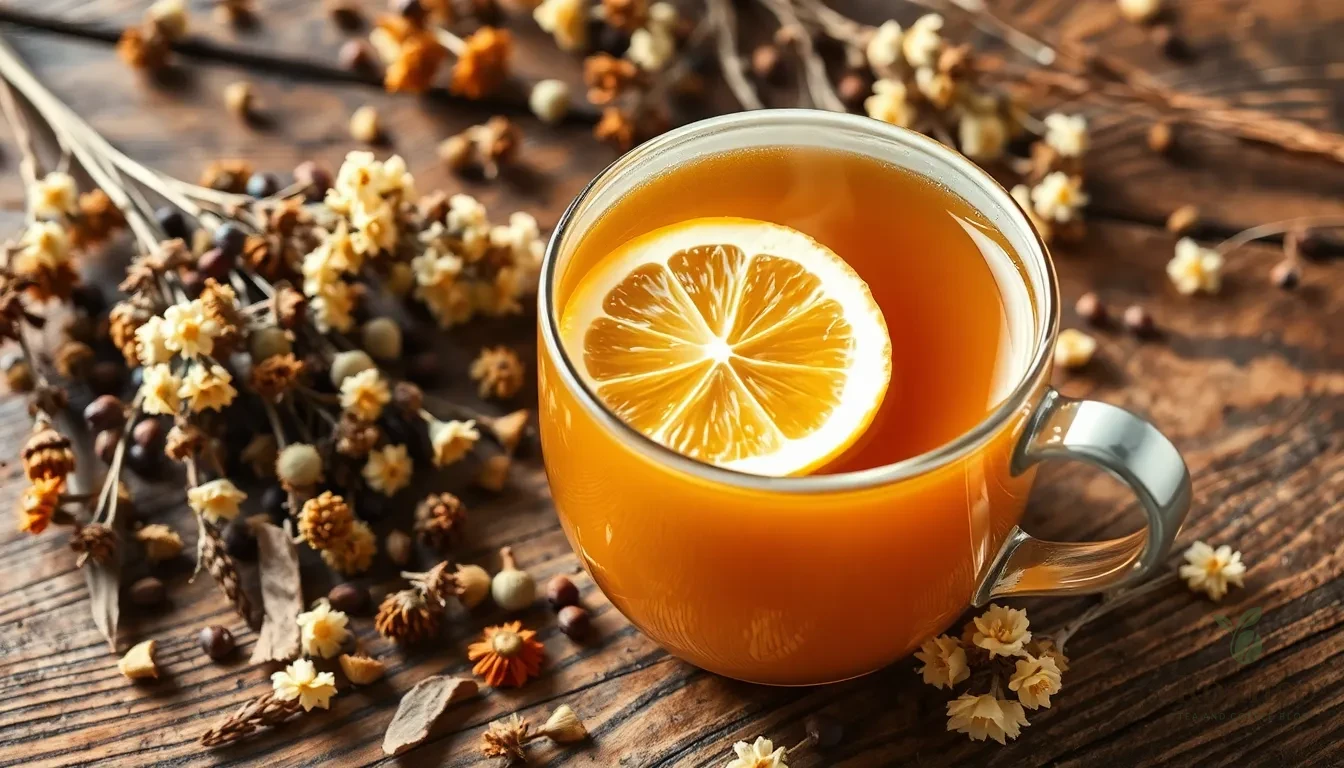
We’ll walk you through two proven methods to brew mullein tea that maximize its therapeutic benefits while ensuring a smooth drinking experience. Both techniques offer distinct advantages depending on your preferences and available time.
Hot Water Brewing Method
We start by measuring 1-2 teaspoons of dried mullein leaves and flowers per cup of water. Place the dried herbs in your teacup or brewing jar.
Bring fresh filtered water to a rolling boil in your medium saucepan. Pour the boiling water directly over the mullein herbs in your cup.
Allow the mixture to steep for 5 to 15 minutes based on your desired strength preference. Longer steeping times create a more potent brew with stronger respiratory benefits.
Strain the tea carefully through a fine mesh strainer or coffee filter to remove all plant material. This step prevents tiny mullein hairs from irritating your throat during consumption.
Serve the tea warm and enhance the flavor with honey, fresh lemon juice, or ginger according to your taste preferences. These additions also provide complementary health benefits.
Cold Water Infusion Method
We recommend using 1-2 teaspoons of dried mullein leaves per cup of water for this gentler extraction method. Place the dried herbs in a clean glass jar or pitcher.
Cover the mullein completely with cold filtered water and stir gently to ensure even distribution. This method uses approximately 4-8 teaspoons per liter of water.
Refrigerate the mixture for 8 to 12 hours or overnight to allow the herbs to infuse slowly. Cold extraction produces a smoother, less bitter flavor profile compared to hot brewing.
Strain the infused tea through fine cheesecloth or a coffee filter to remove all herb particles. The longer steeping time requires thorough filtration to achieve clarity.
Serve chilled over ice for a refreshing herbal drink that maintains all therapeutic properties. The cold infusion method preserves delicate compounds that heat might diminish.
Straining and Serving
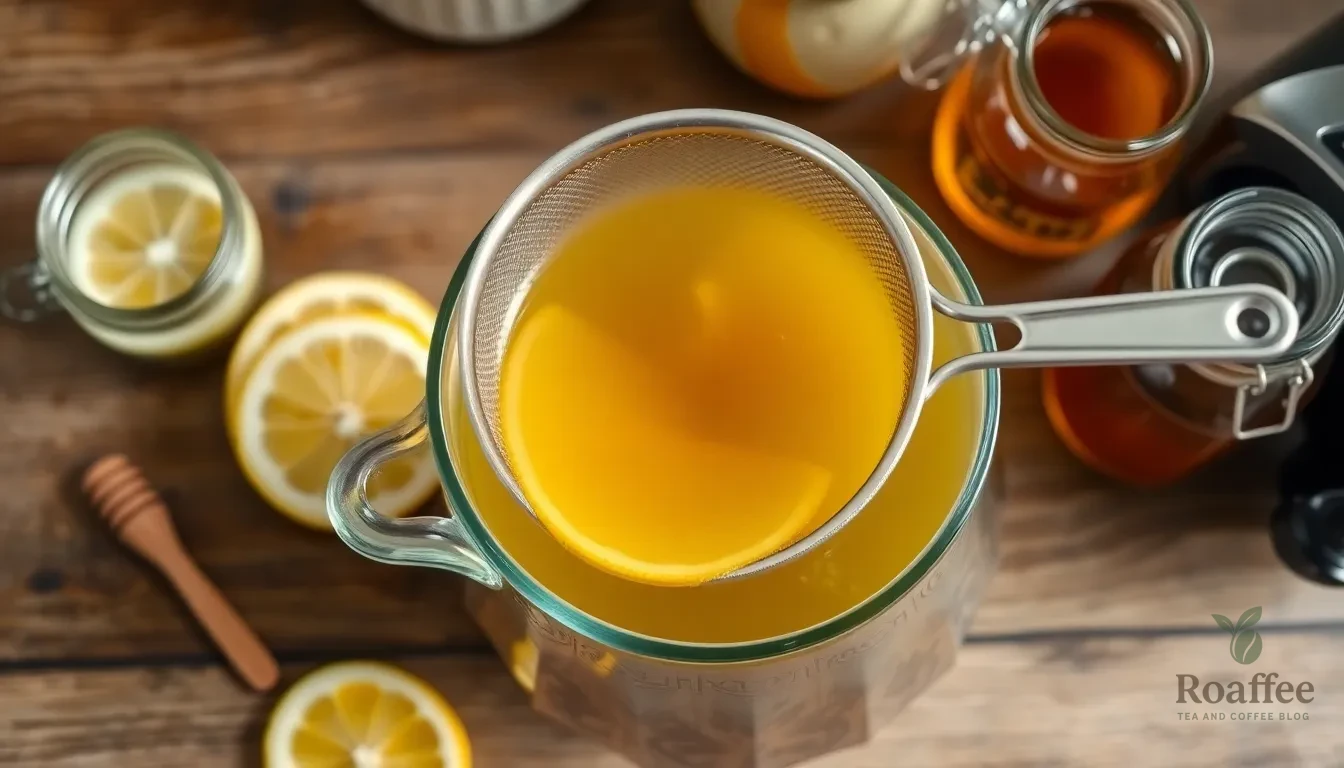
The final steps in preparing mullein tea require careful attention to straining and thoughtful presentation. We ensure our herbal brew delivers maximum comfort and therapeutic benefits through proper technique.
Proper Straining Technique
We recommend using a fine mesh strainer as our primary filtering method to remove larger plant particles. A double layer of cheesecloth provides superior filtration by catching the tiny irritating hairs that can cause throat discomfort. Coffee filters offer another excellent alternative for achieving smooth mullein tea.
Our straining process begins by placing the filter over our serving cup or teapot. We pour the steeped tea slowly through the strainer to allow complete separation of plant material. The fine hairs naturally present in mullein leaves require thorough removal to prevent any potential throat irritation.
| Straining Method | Effectiveness | Best For |
|---|---|---|
| Fine mesh strainer | Good | Basic filtering |
| Double layer cheesecloth | Excellent | Removing fine hairs |
| Coffee filter | Excellent | Smooth consistency |
We press the plant material gently against the strainer to extract remaining liquid without forcing particles through. This technique maximizes our tea yield while maintaining clarity and smoothness.
Serving Suggestions
We serve mullein tea immediately after straining for optimal flavor and temperature. A slice of fresh lemon enhances the mild herbal taste while providing additional vitamin C benefits. Honey complements the gentle earthy notes and adds natural sweetness without masking the therapeutic properties.
Our favorite flavor combinations include adding a pinch of dried mint or blending with chamomile for enhanced relaxation benefits. Peppermint pairs beautifully with mullein for a refreshing twist that soothes both throat and senses.
For iced mullein tea preparation we steep the herbs as directed then allow cooling to room temperature. We serve over ice with honey and fresh peppermint leaves for a refreshing summer variation. This cold preparation method preserves the beneficial compounds while creating an enjoyable warm weather beverage.
We recommend consuming mullein tea within 24 hours of preparation for maximum potency and freshness. The tea maintains its therapeutic properties when stored in the refrigerator for up to one day.
Storage Tips
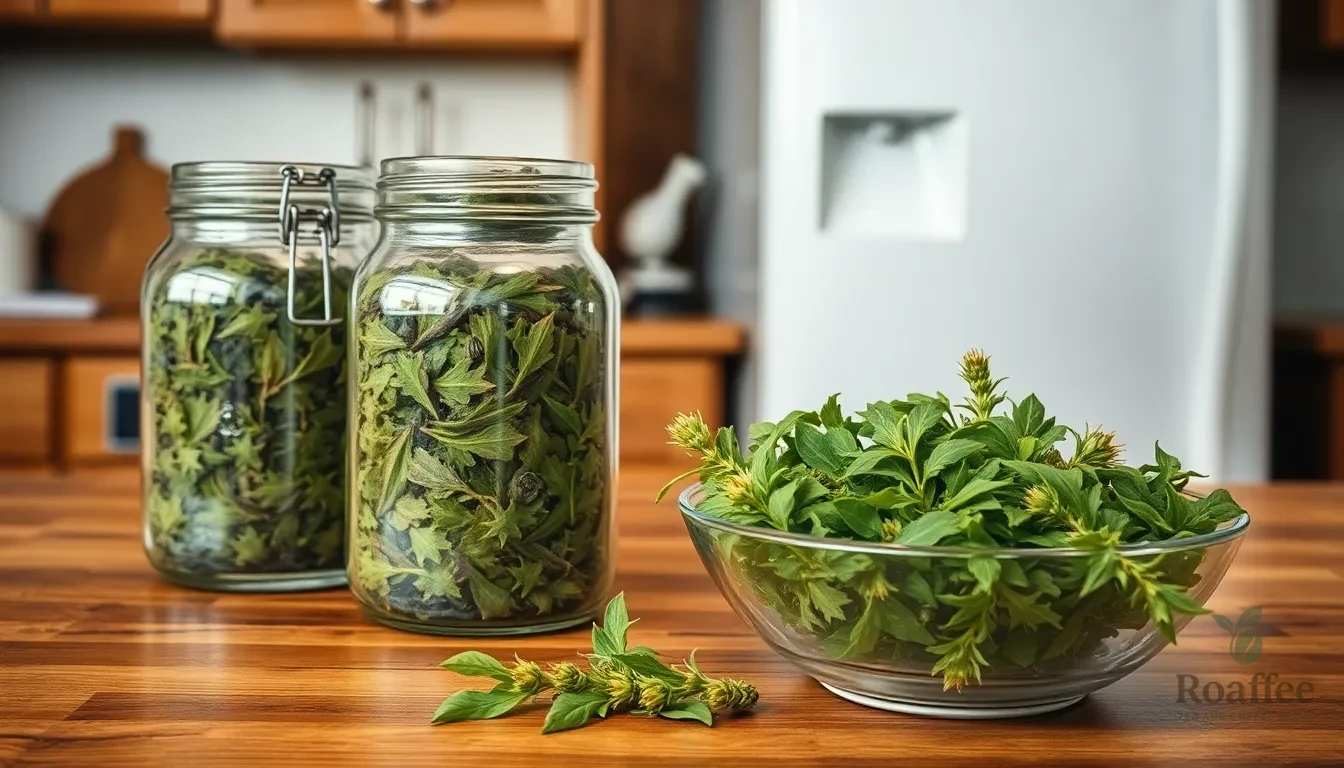
Proper storage of mullein leaves and prepared tea ensures maximum potency and extends shelf life. We’ll guide you through the best practices for storing fresh leaves, dried mullein, and your finished tea.
Storing Fresh Mullein
Fresh mullein leaves work best when used immediately for tea preparation or other herbal applications. We recommend harvesting and brewing fresh leaves on the same day to capture their full therapeutic potential.
When immediate use isn’t possible, store fresh mullein in a cool location or place it in the refrigerator for brief periods before drying. Fresh leaves deteriorate quickly, so we advise against extended storage and suggest moving to the drying process as soon as possible.
Storing Dried Mullein
Dried mullein leaves require complete dehydration before storage to prevent mold and preserve their medicinal properties. We ensure leaves become fully dry and brittle to the touch before moving them to storage containers.
Large leaves should be cut in half to promote even drying throughout the material. Store your dried mullein leaves in paper bags or airtight glass jars positioned away from direct sunlight to maintain their potency.
| Storage Method | Duration | Key Requirements |
|---|---|---|
| Paper bags | 9-12 months | Dark, dry location |
| Airtight jars | 9-12 months | Away from sunlight |
| Properly dried leaves | Up to 12 months | Fully brittle texture |
Properly stored dried mullein leaves maintain their color and medicinal properties for 9 to 12 months before experiencing important degradation.
Storing Prepared Tea
Prepared mullein tea requires refrigeration immediately after straining to maintain freshness and prevent bacterial growth. We recommend storing both cold brewed and hot steeped mullein tea in clean, covered containers in the refrigerator.
Consume your prepared mullein tea within 24 to 48 hours for optimal freshness and safety, following the same guidelines we use for most herbal infusions. This timeframe ensures you receive the full therapeutic benefits while avoiding potential spoilage.
Cold brewed mullein tea typically maintains better flavor stability during storage compared to hot steeped versions. We suggest preparing smaller batches more frequently rather than large quantities that might exceed the recommended storage period.
Dosage and Safety Guidelines
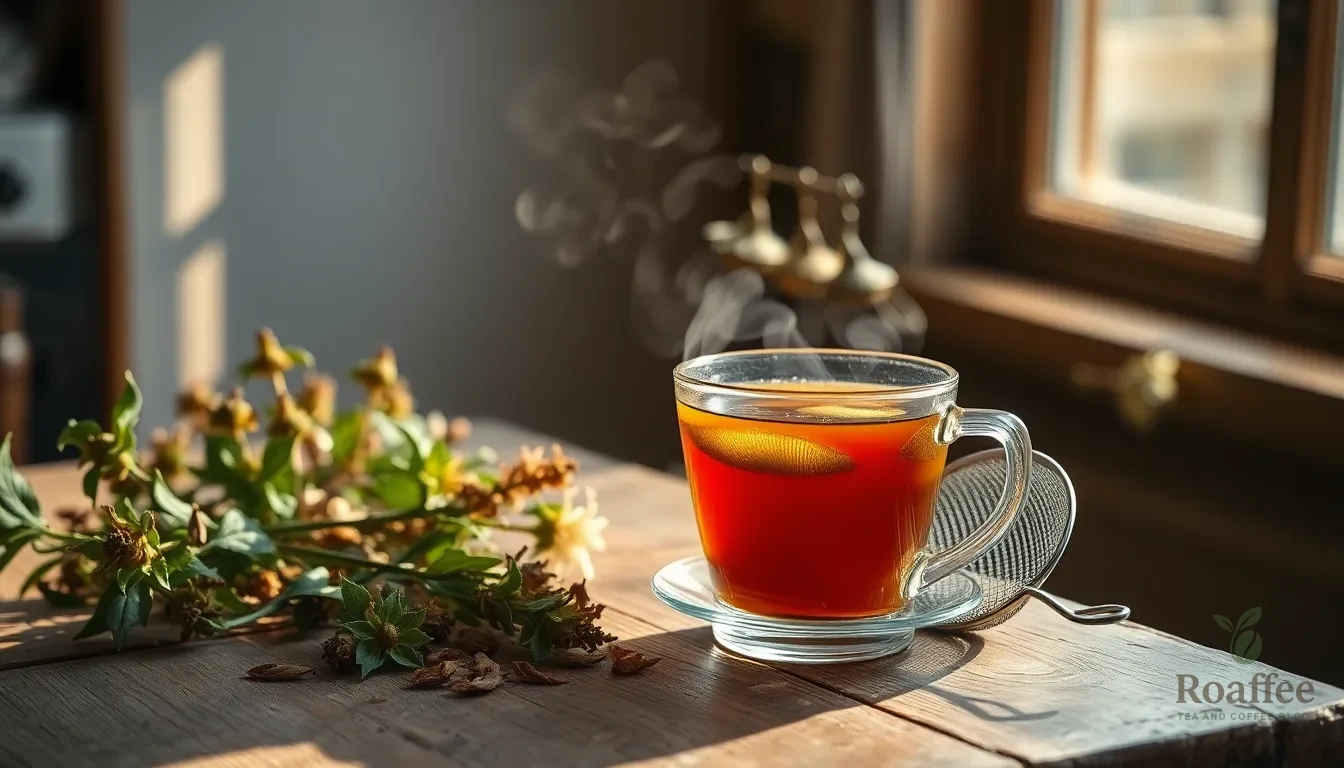
We recommend starting with 2 to 3 cups of mullein tea daily for most adults seeking respiratory support. Studies suggest that some individuals may benefit from consuming 4 to 10 cups per day, though we advise beginning with smaller amounts to assess your body’s response.
Each cup should contain 1 to 2 teaspoons of dried mullein leaves steeped properly according to our brewing methods. This standard measurement ensures you receive therapeutic benefits without overwhelming your system.
| Daily Consumption Guidelines | Recommended Amount |
|---|---|
| Beginner dosage | 2-3 cups daily |
| Therapeutic range | 4-10 cups daily |
| Dried leaves per cup | 1-2 teaspoons |
Safety considerations require our attention when preparing and consuming mullein tea. Allergic reactions can occur in sensitive individuals, manifesting as itching, rash, or swelling. We emphasize the critical importance of thorough straining using fine mesh strainers or cheesecloth to remove tiny plant hairs that may cause throat irritation.
Consultation with healthcare providers becomes essential before starting mullein tea if you are pregnant, breastfeeding, managing chronic health conditions, or taking medications. Drug interactions remain possible, and professional guidance ensures safe consumption alongside your current treatment plan.
Quality selection significantly impacts both safety and effectiveness. We recommend choosing high-quality, third-party tested mullein products to avoid contamination with heavy metals or other toxins. Organic sources provide additional assurance of purity and potency.
Monitoring for side effects helps ensure safe consumption. Rare reactions include skin rash from handling fresh mullein plants, while some individuals may experience digestive sensitivity. We suggest starting with one cup daily and gradually increasing to your desired amount while observing your body’s response.
Duration of use should align with your health goals and professional recommendations. Short-term consumption for acute respiratory issues typically proves safe, while long-term daily use may require periodic evaluation with your healthcare provider.
Flavor Variations and Additions

While mullein tea offers gentle therapeutic benefits on its own, we can enhance both its flavor profile and wellness properties through thoughtful additions. These natural enhancements transform the mild-tasting base into a more complex and enjoyable beverage.
Honey and Lemon
Raw honey serves as the perfect natural sweetener for mullein tea, adding subtle floral notes while providing its own antimicrobial properties. We recommend starting with one teaspoon per cup and adjusting to taste preference. Fresh lemon juice brings bright citrusy notes that complement mullein’s earthy flavor beautifully.
The combination of honey and lemon creates a classic respiratory-supporting blend that many find particularly soothing. A squeeze of fresh lime can substitute for lemon when seeking a slightly different citrus profile. These additions work especially well in both hot and iced preparations, making them versatile options for year-round enjoyment.
Herbal Blends
Mullein pairs exceptionally well with other therapeutic herbs, creating synergistic blends that enhance both flavor and health benefits. Peppermint adds refreshing coolness and digestive support, while chamomile contributes calming properties and gentle floral sweetness. We find that steeping mullein with peppermint and honey creates an ideal iced tea for respiratory relief.
| Herb Addition | Benefits | Flavor Profile |
|---|---|---|
| Peppermint | Respiratory support, digestive aid | Cool, refreshing |
| Chamomile | Calming, anti-inflammatory | Gentle, floral |
| Echinacea | Immune support | Slightly bitter, earthy |
| Ginger | Anti-inflammatory, warming | Spicy, warming |
| Elderflower | Antioxidants, respiratory support | Sweet, floral |
Warming spices like cinnamon, cloves, and nutmeg transform mullein tea into a comforting winter beverage. Ginger root adds anti-inflammatory properties with its characteristic warming sensation. For those seeking caffeine-free sweetening alternatives, stevia provides zero-calorie sweetness without affecting blood sugar levels.
Creative additions include vanilla extract for aromatic depth, milk or plant-based alternatives for creaminess, and eucalyptus for additional respiratory benefits. Fruit juices can be incorporated for natural sweetness and vitamin content, while licorice root adds natural sweetness with its own respiratory-supporting compounds.
Conclusion
We’ve covered everything you need to know about brewing perfect mullein tea at home. From selecting quality ingredients to mastering both hot and cold brewing methods the process is surprisingly straightforward yet rewarding.
Remember that proper straining is crucial for comfort and storing your tea correctly ensures maximum potency. Whether you prefer the traditional hot brew or the smoother cold infusion both methods deliver mullein’s natural respiratory benefits.
Start with our recommended dosage guidelines and don’t hesitate to experiment with flavor additions like honey lemon or complementary herbs. With these techniques you’ll be enjoying this time-tested herbal remedy whenever you need gentle respiratory support.
Your homemade mullein tea is ready to become a valuable addition to your natural wellness routine.
Frequently Asked Questions
What is mullein tea and what are its benefits?
Mullein tea is a natural herbal remedy made from the leaves of the mullein plant. It’s primarily used for respiratory health support, offering gentle relief for breathing issues. The tea is caffeine-free, has a mild flavor, and has been used by herbalists for centuries as a comforting wellness drink.
How do I prepare mullein tea at home?
To prepare mullein tea, you’ll need 1-2 teaspoons of dried mullein leaves, 2 cups of filtered water, and basic equipment like a tea strainer and saucepan. Steep the leaves in boiling water for 5-15 minutes, then strain thoroughly to remove plant material before drinking.
What equipment do I need to make mullein tea?
Essential equipment includes a tea strainer, medium saucepan, measuring cups, and a teacup. Optional items include cheesecloth or coffee filters for extra-smooth straining. These basic tools will help you brew mullein tea effectively and safely at home.
Can I use fresh mullein leaves instead of dried ones?
Yes, fresh mullein leaves can be used for a more potent brew. Use a 2:32 ratio of fresh leaves to water by weight. Handle fresh leaves carefully due to natural irritants, and steep for 10 minutes after pouring boiling water over them.
How long should I steep mullein tea?
For hot brewing, steep dried mullein leaves for 5-15 minutes in boiling water. For cold infusion, soak the leaves in cold water for 8-12 hours. The longer steeping time extracts more beneficial compounds while creating a smoother flavor profile.
Why is straining mullein tea important?
Proper straining removes plant particles and fine hairs that can cause throat irritation. Use a fine mesh strainer, double-layer cheesecloth, or coffee filters to ensure all plant material is removed. This step is crucial for comfort and safety when drinking the tea.
How much mullein tea should I drink daily?
Most adults can safely consume 2-3 cups of mullein tea daily, with some benefiting from up to 4-10 cups per day. Start with smaller amounts and gradually increase. Each cup should contain 1-2 teaspoons of dried mullein leaves properly steeped and strained.
How should I store mullein tea and leaves?
Store dried mullein leaves in airtight containers away from sunlight for up to 12 months. Fresh leaves should be used immediately or refrigerated briefly. Prepared tea must be refrigerated and consumed within 24-48 hours for optimal freshness and safety.
What can I add to mullein tea for better flavor?
Popular additions include raw honey for sweetness, fresh lemon juice for vitamin C, and herbs like peppermint or chamomile for enhanced benefits. You can also add ginger, cinnamon, vanilla extract, or even milk to create different flavor profiles while maintaining therapeutic properties.
Are there any safety concerns with mullein tea?
Mullein tea is generally safe, but some people may experience allergic reactions. Always strain thoroughly to prevent throat irritation from plant hairs. Pregnant or breastfeeding women and those with chronic health conditions should consult healthcare providers before regular consumption.













